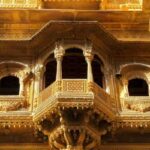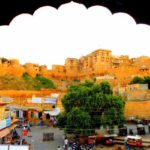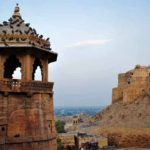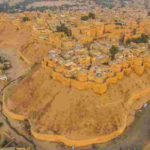Top 10 Historical Places to Visit in Jaisalmer, the “Golden City,” is a treasure trove of historical significance, deeply rooted in the heart of Rajasthan’s Thar Desert. Its history is prominently marked by the imposing Jaisalmer Fort, a UNESCO World Heritage Site, established in 1156 by Rawal Jaisal. This living fort, with its intricate yellow sandstone architecture, houses palaces, temples, and bustling communities, offering a glimpse into a bygone era.
Beyond the fort, Jaisalmer’s historical tapestry is woven with the ornate havelis, such as Patwon Ki Haveli, Salim Singh Ki Haveli, and Nathmal Ki Haveli, showcasing the opulence of the city’s merchant class. The Jain temples within the fort, dating back to the 12th and 15th centuries, reflect exquisite craftsmanship and spiritual heritage. Bada Bagh, with its royal cenotaphs, stands as a solemn reminder of the city’s rulers.
Jaisalmer’s strategic location on ancient trade routes contributed to its prosperity, leaving behind a legacy of cultural fusion and architectural brilliance. These historical landmarks, bathed in the golden hues of the desert, narrate tales of valor, artistry, and enduring traditions.
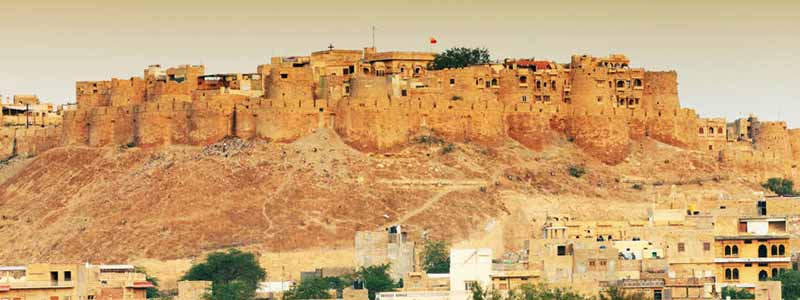
Jaisalmer Fort (Sonar Quila)
Jaisalmer Fort, also known as Sonar Quila or the Golden Fort, is one of the largest living forts in the world. Built in 1156 AD by Rao Jaisal, the fort is a UNESCO World Heritage Site and a major landmark of Jaisalmer.
The fort is constructed from yellow sandstone, which glows golden under the sun, giving it the name Sonar Quila (Golden Fort). It stands 250 feet tall on Trikuta Hill, offering stunning panoramic views of the city. Unlike most forts, it is still inhabited, with over 3,000 people living inside.
Inside the fort, you’ll find narrow lanes, Jain temples, Raj Mahal (Royal Palace), Havelis, and souvenir shops. The Jain temples, built between the 12th and 16th centuries, showcase stunning carvings. The fort also gained fame through Satyajit Ray’s film “Sonar Kella”.
Jaisalmer Fort is a must-visit destination for history lovers, offering a glimpse into Rajasthan’s royal past and vibrant culture.
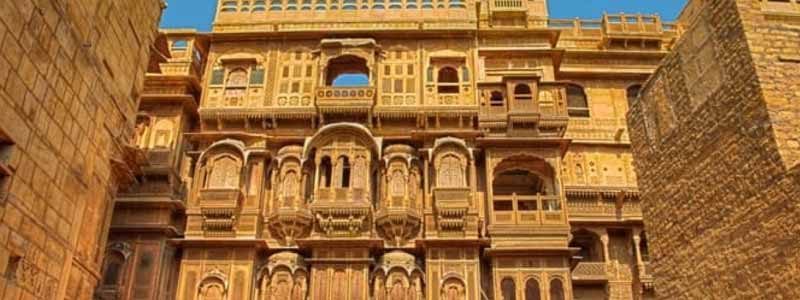
Patwon Ki Haveli
Patwon Ki Haveli is one of the most famous historical landmarks in Jaisalmer, Rajasthan. Built in 1805 by Guman Chand Patwa, a wealthy trader, this haveli is a stunning example of Rajasthani architecture and intricate craftsmanship. It is a cluster of five havelis, making it the largest haveli complex in Jaisalmer.
The intricately carved jharokhas (balconies), grand archways, and detailed murals reflect the opulence of the bygone era. The walls are adorned with beautiful mirror work and paintings, showcasing the artistic excellence of the time. The first haveli was built exclusively for the Patwa family’s residence, while the others were later constructed for commercial purposes.
Today, the haveli houses museum exhibits showcasing artifacts, furniture, and artwork from Jaisalmer’s rich past. Located near Jaisalmer Fort, it is a must-visit for history lovers and architecture enthusiasts. The fine craftsmanship and historical significance make Patwon Ki Haveli an unforgettable experience in the Golden City.
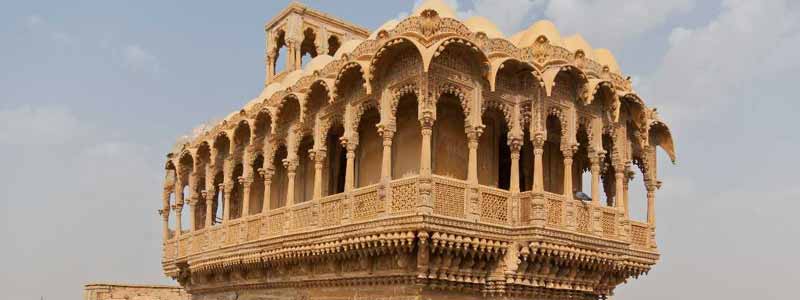
Salim Singh Ki Haveli
Salim Singh Ki Haveli is an 18th-century architectural marvel in Jaisalmer, built by Salim Singh, the Prime Minister of the kingdom. This haveli is known for its unique peacock-shaped roof, 38 intricately carved balconies, and an unusual design where the structure expands as it rises.
Made from yellow sandstone, the haveli stands out with its arched windows and elaborate frescoes. It was originally built to rival the Jaisalmer Fort, but legend says the king restricted its height. The haveli was once a residence of royalty and still reflects the grandeur of a bygone era.
Visitors can admire its blue cupolas, delicate carvings, and impressive corridors, offering a glimpse into the rich heritage of Rajasthan. A visit to this haveli is a must for history and architecture lovers exploring Jaisalmer.
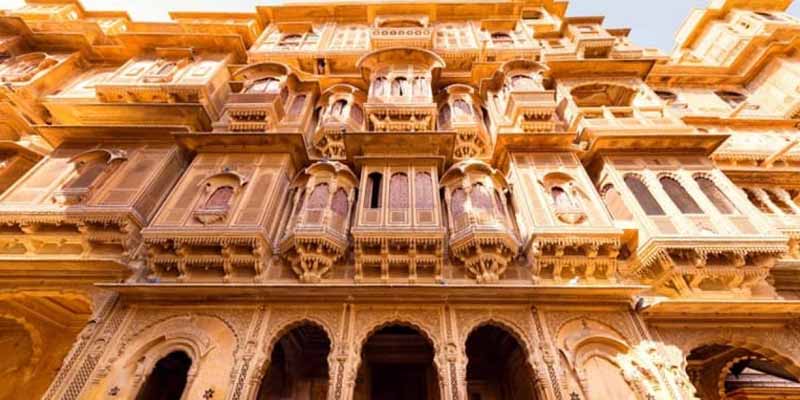
Nathmal Ki Haveli
Nathmal Ki Haveli is an architectural masterpiece in Jaisalmer, built in the 19th century as the residence of Prime Minister Nathmal. The most fascinating aspect of the haveli is that two architect brothers built it simultaneously from opposite sides, resulting in a structure that, while similar, is not perfectly symmetrical.
The haveli features intricate sandstone carvings, golden-hued exteriors, and a blend of Rajput and Islamic architecture. The beautifully carved balconies, elephant sculptures, and exquisite interiors adorned with miniature paintings and murals make it a sight to behold.
Unlike other havelis in Jaisalmer, Nathmal Ki Haveli also showcases modern influences, with depictions of cars and fans in its carvings. It remains a significant attraction for history and art lovers visiting Jaisalmer.
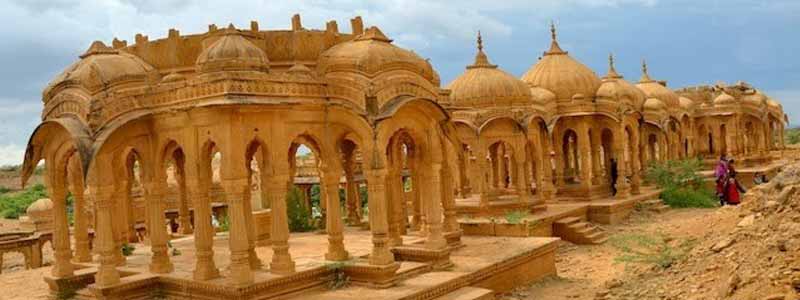
Bada Bagh
Bada Bagh, meaning “Big Garden,” is a historic site in Jaisalmer, famous for its royal cenotaphs (chhatris) of the Maharajas of Jaisalmer. Built in the 16th century by Maharawal Jait Singh and completed by his son Lunakaran, it serves as a memorial to the rulers of the Bhati dynasty.
The site features intricately carved cenotaphs made of yellow sandstone, offering a stunning contrast against the desert backdrop. These chhatris, dedicated to the kings, queens, and royal family members, showcase exquisite Rajasthani architecture with domed structures and carved pillars.
Located on a hilltop, Bada Bagh provides a breathtaking sunset view, making it a favorite for photographers and history lovers. The serene atmosphere and rich historical significance make it a must-visit in Jaisalmer.
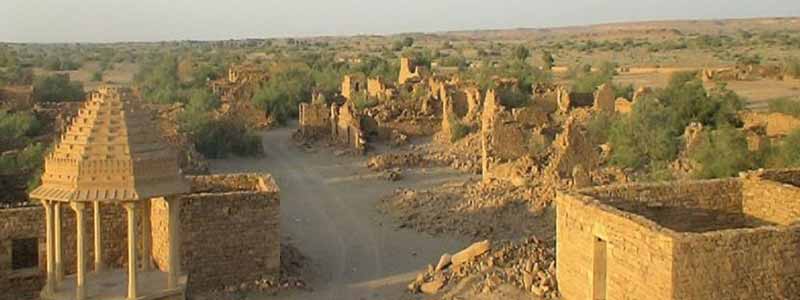
Kuldhara Abandoned Village
Kuldhara is a mysterious abandoned village near Jaisalmer, believed to be haunted and cursed. Established in the 13th century by the Paliwal Brahmins, it was once a prosperous settlement. However, in the 19th century, the entire village, along with nearby settlements, was abandoned overnight.
According to legend, the cruel Diwan of Jaisalmer, Salim Singh, imposed heavy taxes and wanted to marry a village girl against her will. To protect their honor, the villagers left overnight, cursing Kuldhara so that no one could ever live there again.
Today, the ruins of houses, temples, and narrow lanes tell the story of a once-thriving community. The eerie silence and desolate landscape make it one of the most intriguing places in Jaisalmer. It is now a popular tourist spot, especially for those interested in history, mystery, and ghost stories.
Tazia Tower
Tazia Tower is a five-story architectural marvel in Jaisalmer, located near Badal Palace. Built in the 19th century by Muslim artisans for the royal family, this tower represents Tazia, a replica of the mausoleums carried during Muharram.
Each floor of the tower has a unique design, featuring intricate balconies, delicate carvings, and Rajput-Mughal fusion architecture. The craftsmanship reflects the artisans’ devotion, with each level narrating a different story through its architectural style.
Unlike other sandstone structures in Jaisalmer, Tazia Tower showcases Islamic influences, making it stand out against the city’s predominantly Rajput-style buildings. Its towering presence and detailed artistry make it a significant historical site.
Visitors can admire its ornate façade and breathtaking views of the Golden City from the top. It is an ideal spot for history lovers and photographers, Top 10 Historical Places to Visit in Jaisalmer.
Jain Temples (Inside Jaisalmer Fort)
The Jain Temples inside Jaisalmer Fort are a group of seven stunning temples built between the 12th and 16th centuries, dedicated to Tirthankaras of Jainism. These temples are renowned for their intricate carvings, exquisite architecture, and stunning sculptures, crafted from yellow sandstone, blending seamlessly with the fort’s golden hue, Top 10 Historical Places to Visit in Jaisalmer.
Among the most famous are the Chandraprabhu Temple, Parsvanath Temple, and Rishabhdev Temple, each adorned with delicate toranas (arches), finely sculpted pillars, and detailed wall carvings depicting Jain mythology. The temples showcase Dilwara-style craftsmanship, similar to the famous Mount Abu Jain Temples.
These temples serve as a spiritual and historical treasure for both pilgrims and architecture lovers. Visitors are advised to explore them early in the morning for a peaceful experience.
Vyas Chhatri
Vyas Chhatri is a stunning cenotaph complex in Jaisalmer, dedicated to the great sage Veda Vyas, the author of the Mahabharata. Located on a small hill, it serves as a cremation ground for Brahmins and is known for its elegant Rajasthani-style chhatris (domed pavilions) made of yellow sandstone.
These cenotaphs feature intricate carvings, delicate pillars, and open-air structures, offering a glimpse into Jaisalmer’s architectural beauty. Often called the “Sunset Point of Jaisalmer,” it provides breathtaking views of the Golden City, especially during the evening when the sandstone glows in golden hues.
A peaceful and historically rich site, Vyas Chhatri is a must-visit for photographers, history enthusiasts, and those looking to experience the spiritual and architectural grandeur of Top 10 Historical Places to Visit in Jaisalmer.
Gadsisar Lake
Gadsisar Lake is a historic artificial lake built in the 14th century by Maharawal Gadsi Singh as a water conservation reservoir. Once the primary water source for Jaisalmer, it now serves as a serene getaway and a hub for birdwatching, especially during winter.
The lake is surrounded by intricately carved chhatris, temples, ghats, and gateways, the most famous being the Tilon Ki Pol, a beautifully sculpted arched entrance. The calm waters reflect the golden-hued architecture, creating a breathtaking view. Visitors can enjoy boating, admire the ancient shrines, or relax by the tranquil banks.
Gadsisar Lake is also home to migratory birds like Siberian cranes, making it a paradise for bird lovers and photographers. The sunrise and sunset views here are magical, making it a Top 10 Historical Places to Visit in Jaisalmer

